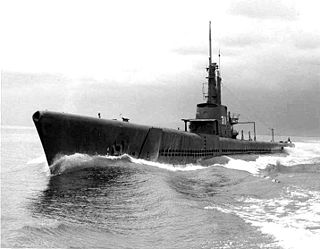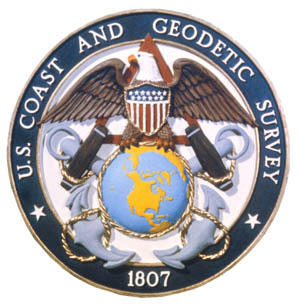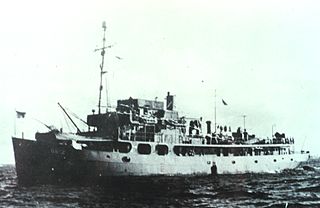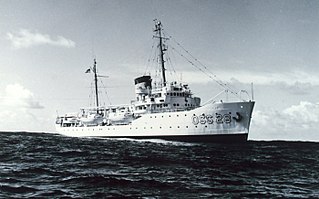
USS Independence (CVL-22) was a United States Navy light aircraft carrier. The lead ship of her class, she served during World War II.

The National Oceanic and Atmospheric Administration Commissioned Officer Corps is one of eight federal uniformed services of the United States, and operates under the National Oceanic and Atmospheric Administration (NOAA), a scientific agency overseen by the Department of Commerce. The NOAA Corps is made up of scientifically and technically trained officers. The NOAA Corps and the United States Public Health Service Commissioned Corps are the only U.S. uniformed services that consist only of commissioned officers, with no enlisted or warrant officer ranks. The NOAA Corps' primary mission is to monitor oceanic conditions, support major waterways, and monitor atmospheric conditions.

Mahan-class destroyers of the United States Navy were a series of 18 destroyers of which the first 16 were laid down in 1934. The last two of the 18, Dunlap and Fanning, are sometimes considered a separate ship class. All 18 were commissioned in 1936 and 1937. Mahan was the lead ship, named for Rear Admiral Alfred Thayer Mahan, an influential historian and theorist on sea power.

USS Archerfish (SS/AGSS-311) was a Balao-class submarine. She was the first ship of the United States Navy to be named for the archerfish. Archerfish is best known for sinking the Japanese aircraft carrier Shinano in November 1944, the largest warship ever sunk by a submarine. For this achievement, she received a Presidential Unit Citation after World War II.
Lake Washington Shipyards was a shipyard in the northwest United States, located in Houghton, Washington on the shore of Lake Washington, east of Seattle. Today, the shipyards are the site of the lakeside Carillon Point business park. The shipyards built many civilian and U.S. Navy ships.

USS Flamingo (AM-32) was a Lapwing-class minesweeper built for the United States Navy near the end of World War I. After service overseas clearing mines after the Armistice, the ship was laid up until 1922 when she was transferred to the United States Department of Commerce for use by the United States Coast and Geodetic Survey. Renamed USC&GS Guide, the ship operated as a survey vessel along the West Coast of the United States for 17 years, making significant contributions to navigation, hydrographic surveying, and oceanography. In June 1941, Guide was transferred back to the Navy, converted into a salvage ship, and renamed USS Viking (ARS-1). As Viking, she worked primarily from bases in California until 1953, when she was sold for scrapping.

USS Castor (AKS-1) was a Castor-class general stores issue ship commissioned by the U.S. Navy for service in World War II. She was responsible for delivering and disbursing goods and equipment to locations in the war zone.

USS Oceanographer (AGS-3) was a survey ship of the United States Navy during World War II that produced charts chiefly of passages in the Solomon Islands area of the Pacific Ocean. Upon transfer to the Navy, she had initially briefly been named and classed as gunboat USS Natchez (PG-85). Before her World War II Navy service, she had been USC&GS Oceanographer (OSS-26), a survey ship with the United States Coast and Geodetic Survey from 1930.

The United States Coast and Geodetic Survey was the first scientific agency of the United States Government. It existed from 1807 to 1970, and throughout its history was responsible for mapping and charting the coast of the United States, and later the coasts of U.S. territories. In 1871, it gained the additional responsibility of surveying the interior of the United States and geodesy became a more important part of its work, leading to it being renamed the U.S. Coast and Geodetic Survey in 1878.

USS Hydrographer (AGS-2), briefly classified PY-30 before commissioning, was built in 1928 by the Spear Engine Works in Norfolk, Virginia, and operated as a survey ship along the Atlantic coast and in the Caribbean for the United States Coast and Geodetic Survey. Acquired by the United States Navy in April 1942, she was converted for U.S. Navy service by the Choctaw Boat Works in Alabama and commissioned as AGS-2 at Mobile, Alabama on 20 May 1942.

USS Elder (AN-20/YN-15) was an Aloe-class net laying ship which was assigned to serve the U.S. Navy during World War II with her protective anti-submarine nets.

USS Mobjack (AVP-27/AGP-7) was a motor torpedo boat tender in commission in the United States Navy from 1943 to 1946. She saw service in the Pacific theater during the latter portion of World War II.

USS Surveyor was an armed steamer that served in the United States Navy from 1917 to 1919. Prior to her U.S. Navy service, she operated as the survey ship USC&GS Surveyor for the United States Coast and Geodetic Survey in 1917, and she returned to that role after her U.S. Navy decommissioning, remaining in Coast and Geodetic Survey service until 1956.

The second USC&GS Fathomer was a steamer that served as a survey ship in the United States Coast and Geodetic Survey from 1905 to 1942.

USC&GS Romblon was a steamer, owned by the Philippine Insular Government, that served exclusively in the Philippines. The ship was purchased by the Philippine Bureau of Coast Guard and Transportation to support both government logistical and administrative travel needs as well as the usual functions of a coast guard vessel. The vessel was transferred to the United States Coast and Geodetic Survey serving as a survey ship from 1905 to 1932. Romblon and Marinduque were sister ships, both built in Japan.

USC&GSS Research was a survey vessel owned by the Philippine Insular Government to be the first vessel operated by the United States Coast and Geodetic Survey in the Philippines from 1901 until 1918.

The first USC&GSS Pathfinder, also noted in some NOAA histories as "old Pathfinder", was a United States Coast and Geodetic Survey ship in service from 1899 to 1941, when she was beached in sinking condition on January 30, 1942, after 40 years service in the Philippines.

The second USC&GS Explorer was a survey ship that served in the United States Coast and Geodetic Survey from 1940 to 1968. She operated in the Pacific Ocean from 1940 to 1960, seeing service there during World War II, and in the Atlantic Ocean from 1960 to 1968.

Rear Admiral Harley Dean Nygren was an American military officer who served in the United States Coast and Geodetic Survey Corps, its successor, the Environmental Science Services Administration Corps, and the ESSA Corps's successor, the National Oceanic and Atmospheric Administration Commissioned Officer Corps. He served as the first Director of the NOAA Corps.

MV Brown Bear was an American research vessel in commission in the fleet of the United States Department of Agriculture′s Bureau of Biological Survey and Alaska Game Commission from 1934 to 1940 and in the fleet of the United States Department of the Interior′s Fish and Wildlife Service from 1940 to 1942 and from 1946 to 1951, under the control of the University of Washington from 1952 to 1965, and in commission in the fleet of the United States Fish and Wildlife Service from 1965 to 1970 and of the National Oceanic and Atmospheric Administration′s National Marine Fisheries Service (NMFS) from 1970 to 1972.



















